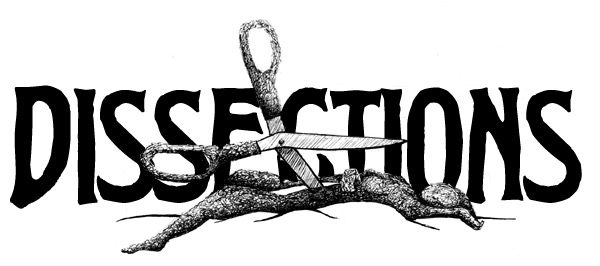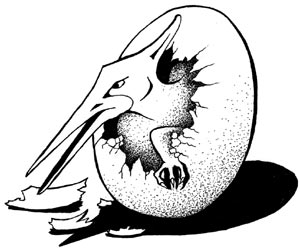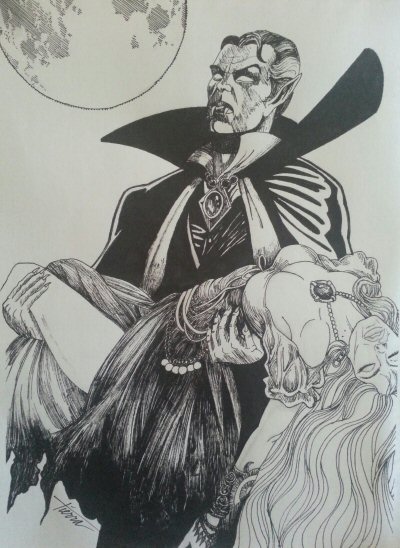[an error occurred while processing this directive]



Artwork by Tierra Jackson
Victorians and Vampires: Anxiety at First Bite Danielle
Dean
Sodomy, sin, and sex: in a society drowning in repression, the Victorians both feared and valued that which they were too fearful to admit the truth of. In this era, genuine candor was often treated as secondary and less ideal than maintaining false and superficial pretenses of society. The Western world treated humanity’s “abnormal” desires and social issues as either nonexistent or demonized by the masses; they utilized the concept of the forbidden chamber frequently in their socially anxious community. Thus, in order to address truth in cautious manners, monsters and villain archetypes in the literary world were created to serve as the personification of Western society’s deeper desires and unspoken fears. Monsters therefore reflect the human fears of the era in which they are created, though their significance transcends time and literature.
Art, as in many centuries both preceding and following the period of Victorian life and thriving culture, seeks to speak volumes about issues without being direct about them. In this, authors can get away with using monsters as scapegoats; they represent the metaphorical “shadow” Victorians were too anxious to peer into or acknowledge. An important characteristic of monsters that has been imprinted through Victorian era literature is the stereotyping and projection of the vampire as an overtly sexual, demonized creature representing the “Other”. In Dracula, the title character is an Eastern European aristocrat who travels to England for the sake of conquering and expanding his race; both xenophobic and promiscuous, these mannerisms attached to the vampire myth allude to Western fears of invasion and the introduction of the foreign “Other”. This stereotype both demonizes and condemns outsiders who do not fit into the Victorian mold of what is considered socially “normal” or acceptable, and may range from foreigners to those of sexually diverse backgrounds or orientations. In Dracula’s case, he fits into the mold of all three.
John Allen Stevenson, in his analysis of the character Dracula within “A Vampire in the Mirror: The Sexuality of Dracula”, theorizes that Stoker’s markings of the Count as a member of the “Other” and the interpretation of his title character “defines the vampire not as a monstrous father but as a foreigner, as someone who threatens and terrifies precisely because he is an outsider.” (Stevenson, 139) The concept of foreign powers invading one’s homeland and robbing western men of their land and women has been a notion of fear used for centuries. Victorians in particular, who were citizens of England during its most active point in global colonization, supported and spread this xenophobic propaganda. This claim is further supported in the text of Dracula itself; in his desire to explain the origin of vampires to Seward and friends, Van Helsing expresses that the vampire is “known everywhere that men have been found” and speaks of the creature as an invader who has traversed through “old Greece, in old Rome; he flourish in Germany all over, in France, in India, even in Chernosese…” (Stoker, 257) The concept of the vampire is even referred to as having Eastern European origins, when Van Helsing states that to become a member of Dracula’s Undead is to “become nosferatu, as they call it in Eastern Europe.” (Stoker, 230) Dracula, in his Eastern European and stereotypical power hungry glory, is the perfect representation of these fears cemented and personified under the guise of a supernatural villain.
Perhaps an even more prominent theme, the concept of sexuality and promiscuity are domineering forces in Victorian vampire literature, and remain a trait that has, for the majority, passed onto contemporary vampire narratives. The vampire myth is deeply rooted in the sexual awakening of women and the underlying theme of homoeroticism that remained a factor of immense anxiety for Victorian society and its false pretenses of propriety. In Stoker’s Dracula, the “weird sisters” in combination with more major female roles, such as Lucy Westenra, are sexually independent, “voluptuous” women who are seen as debauched and irresistible symbols of promiscuity. Their ability to make decisions about their bodies and sexuality on their own terms and without the presence or acceptance of their male counterparts depicts them as outliers in a conservative Western society. Stevenson quotes Judith Weissman, who writes that “Dracula is an extreme version of the stereotypically Victorian attitudes towards sexual roles.” (Stevenson, 145)
In an attempt to shift and pinpoint the blame, vampires flourished in Victorian literature and are thus seen as the crux of this sexual awakening; they are to be demonized as monsters intent on deflowering and corrupting otherwise virtuous women. In “The Narrative Method of Dracula”, David Seed refers to a statement made by Stephanie Demetrakopoulos on Dracula, in which the sexual themes of the novel are addressed as being “masked and symbolic; it can be enjoyed surreptitiously and hence denied even to oneself.” (Seed, 61) Likewise, Victorians were able to privately or subconsciously enjoy the liberation of sex and promiscuity while still denying any acknowledgement or support of sexual enlightenment. The sexual prowess of the female gender is a forbidden chamber in the eyes of socially anxious Victorian society, and so any explanation for the New Woman’s liberation must be villainized. Seed explains that arguments made in support of this case for the novel stakes a claim that Dracula “introduces issues that the English characters treat as taboo.” (Seed, 62) This is expressed through Lucy Westenra in particular; as she falls victim to Dracula’s advances and starts to become a member of the Undead, she is spotted by Van Helsing and company in the graveyard and speaks to Arthur, her lover in life. The unapologetic temptress Lucy has become in their eyes takes over, and she moves towards them with a “languorous, voluptuous grace.” (Stoker, 227) Lucy is a take charge, desirable woman even in her Undead state of being; she knows what she wants, and even goes so far as to incite Arthur to join her, declaring that he should “come to” her and that “my arms are hungry for you.” (Stoker, 227) Rather than any of her known friends acknowledging that Lucy was a barely restrained flirt in life who unashamedly wished for the power to “let a girl marry three men, or as many as want her”, the blame for Lucy’s lusty behavior rests entirely on the seduction and corruption via Dracula. (Stoker, 63)
But despite Lucy’s near descent into the world of the Undead as one of Dracula’s many wives, she is “saved” and her former purity preserved by the men in her life. As they restore Lucy to her former glory after slaying the “voluptuous” beast within, John Seward remarks that they look upon her “as we had seen her in her life, with her face of unequalled sweetness and purity.” (Stoker, 232) With her burgeoning sexuality and independence slaughtered, Lucy is able to once again serve as an icon of virtue in their eyes; she retains an image of what a traditional Victorian woman is meant to embody—beauty, submission, and untouched purity. In contrast, Dracula’s wives—women whose histories we know little of, except that they are likely of Eastern European origin as the Count is—are treated as members of the “Other” along with their husband. The “weird sisters”, as they have been so frequently dubbed, are viewed as promiscuous monsters. Their sexual dominance and repeated identifications of being “voluptuous” define them as monsters to be wary of and slain rather than women in need of rescuing. Likewise, Stevenson touches on this subject, declaring that “women who are ‘pure’ are not only good, they are recognizable as members of the group” whereas characters such as Dracula’s wives are condemned as “loathsome creatures fit only for destruction.” (Stevenson, 145)
This same idea of sexual prowess and promiscuity transcends Dracula and remains applicable to vampire literature and lore of its time. John Polidori’s “The Vampyre” features women seduced and lured into sexual temptation through the vampiric character of Lord Ruthven. Ruthven, a notoriously apathetic nobleman and womanizer, has what the Victorians would consider to be a terrible habit of seducing women into corruption. When the protagonist, Aubrey, discovers that Ruthven plans a night of scandal with a woman they meet on their tour of Europe, he confronts the Lord with the mindset that such a meeting would “most likely end in the ruin of an innocent, though thoughtless girl.” (Polidori, 73) Though the woman could be considered complacent in her desires as well in this instance, her sexual awakening is ignored in favor of the protection of her virtue. This implementation of Victorian social laws in a foreign country further supports the claim that the Victorians were the product of mass colonization and ignorance that the anxieties of their own community might not stretch past their own country’s natural borders. Further isolating Ruthven as the villain and the lone vampire of the narrative, the nobleman’s dark methods of seduction are viewed in stark contrast to that of Aubrey. While Aubrey represents duty, pride, and morality in his decisions and actions throughout the story, consistently striving to oppose the corruption of and preserve the purity of women, Lord Ruthven is the cold and cruel member of the “Other”; there is a discernible difference between him and other socially adept members of society.
In addition to the concept of sexual awakening and independence come the underlying theme of homoeroticism and the question of sexuality that was so readily condemned or ignored during the Victorian period. Vampires, maintaining that same sense of notoriety and promiscuous tendencies as mentioned earlier, seem to have sexual desires and sultry appeal that transcend sexualities and genders. As homosexuality was considered to be both sodomy and an unforgivable sin in the eyes of repressive Victorian England, authors and artists tended to be somewhat subtle with themes of same sex relationships, whether subconsciously or otherwise. Following David Seed’s previously stated assertion that Dracula follows “taboo issues”, the Count’s expressions of desire and lust are communicated homoerotically within the piece, as well. (Seed, 62) When John Harker is preyed upon by the “weird sisters” during his stay at Count Dracula’s estate, for instance, he is saved only at his Undead host’s urging and possessiveness; when the women attempt to kiss and claim Harker as their own, Dracula angrily demands “How dare you touch him, any of you? How dare you cast eyes on him when I had forbidden it? […] This man belongs to me!” (Stoker, 41) This anger and possessiveness blurs the lines of platonic and homoerotic desire for ownership and creates an unspoken bond between Dracula and Harker. Dracula could have feasted upon Harker for himself that evening, but instead spares and protects him, all while marking Jonathan as one of his belongings.
Likewise, this theme of homoeroticism is further supported in the narrative by the character of Renfield, who views Dracula as a bride for the taking. Based on the outcome of these characters, it may be supposed that the homoerotic undertones of Dracula are more prevalent than may be first assumed. Renfield, who both worships and adores Dracula, is betrayed and killed within the realm of the novel. Likewise, Dracula himself—the monster who begins the entire sordid ordeal—the readers may presume to be dead by the narrative’s conclusion. Jonathan Harker, on the other hand, after previously being involved in such a uniquely intimate relationship with Dracula, is spared by inserting himself into a typical Victorian-accepted family and romantic relationship at the novel’s closing. Talia Schaffer’s “‘A Wilde Desire Took Me’: The Homoerotic History of Dracula” discusses how Harker has “learned to love the memory of his internment in Castle Dracula, and has organized both a homosocial band of ‘brothers’ and a bourgeois family to revolve endlessly around that nucleus.” (Schaffer, 382) By “normalizing” himself, Harker escapes the fates of those who didn’t repress their burgeoning sexualities.
This same theme of repressed sexuality and its consequences may also be found within Polidori’s “The Vampyre”. Like Dracula, this text involves a unique relationship between two major male characters—the protagonist and antagonist, respectively—that blurs the line between platonic and erotic. Lord Ruthven and Aubrey’s trek across Europe together, as fragmented and dark as it may be, is initiated by their magnetic interest in one another. Aubrey’s immediate fixation on Ruthven marks their affair a passionate one; when first introduced, Aubrey is enchanted by “the very impossibility of forming an idea of the character of a man entirely absorbed in himself” and immediately sets out to learn all he can of the mysterious, seemingly-apathetic man who later becomes his companion. (Polidori, 70) Mair Rigby’s publication, “Polidori’s Queer Vampyre at the Margins of Romanticism”, further examines this relationship between Aubrey and Ruthven, dubbing them as “men who traverse the explosively tense line between compulsory homosocial relations and the culturally prohibited horrors of homoerotic desire.” (Rigby) As the narrative expands and the female sex threatens to break their bond apart, the reader may infer that Ruthven kills Aubrey’s budding love interest, Ianthe, so that he may have Aubrey entirely to himself once more. When Aubrey is thereafter bedridden and ill, Lord Ruthven is said to arrive upon the scene and “immediately placed himself in the same house, and became his [Aubrey’s] constant attendant.” (Polidori, 77) Though Ruthven is known to the audience as a cruel and detached womanizer at this point in the narrative, his passionate determination to stay by Aubrey’s side places him as the invalid’s caretaker and marks possessiveness over him. And despite Aubrey’s initial reservations over aligning himself with Lord Ruthven once more, he is quickly wooed on the contrary by Ruthven’s “kind words […] and still more by the attention, anxiety, and care which he showed”, stating that these above all else “reconciled him to his presence.” (Polidori, 77)
Though the homoerotic relationships present in both Dracula
and “The Vampyre” are based in monstrous attraction, repulsion,
and repression, both tales speak volumes of the Victorians’ forbidden
chamber and how artists viewed and questioned sexuality in a time period
when to do so was punishable by law. Sexuality—whether through
the liberation of women as independent beings or homosexual relations—bear
the markings of the shadow Victorian anxiety and culture cast over the
rest of the world, and are present in this era’s Gothic vampire
literature in abundance. While these staples in classic horror literature
mark the era in which they were created, Dracula and “The
Vampyre” possess core values and fears that reflect themselves
in modern Western society to this day. Though their releases date back
centuries past, the context of the monster is as raw and fresh as its
inception. The vampires and their sexualized, homoerotic lore are the
faceless monsters of a culturally repressed society. The heart of the
monster is not based in the supernatural, but instead serves as the
manifestation of the fears a culturally repressed society produce.
Works Cited
Polidori, John William. “The Vampyre.” Three Vampire
Tales. Boston: Houghton Mifflin, 2003. 68-85. Print.
Rigby, Mair. “‘Prey to Some Cureless Disquiet’: Polidori’s Queer Vampyre at the Margins of Romanticism.” Romanticism on the Net. Erudit. Nov. 2004. Web. 24 Nov. 2016.
Schaffer, Talia. “‘A Wilde Desire Took Me’: The Homoerotic History of Dracula.” ELH, vol. 61, no. 2, 1994, pp. 381-425.
Seed, David. “The Narrative Method of Dracula.” Nineteenth-Century Fiction, vol. 40, no. 1, 1985, pp. 61-75.
Stevenson, John Allen. “A Vampire in the Mirror: The Sexuality of Dracula.” PMLA, vol. 103, no. 2, 1988, pp. 139-149.
Stoker, Bram. Dracula. New York: Bantam, 2004.
Print.
**************************************************************************
